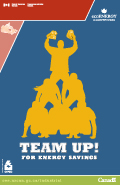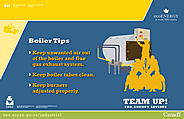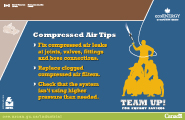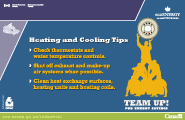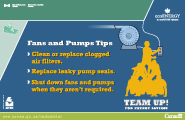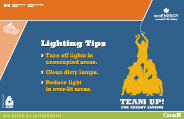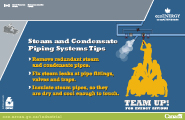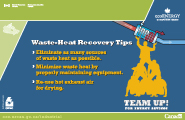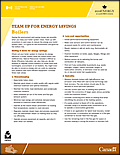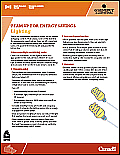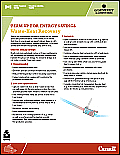Employee awareness of energy efficiency
Employee support is vital to ensure the success of your energy management initiatives. A comprehensive employee awareness program (EAP) can help engage your staff and show how they can reduce energy waste, decrease operating costs and increase competitiveness.
To help you develop and deliver your own EAP, Natural Resources Canada (NRCan) has developed the following:
Team Up! For Energy Savings
This web-based guide will help you build an energy-saving culture in your workplace.
EAP toolkit
The toolkit offers free, ready-to-use resources including posters, fact sheets, slide presentations and a detailed version of the Team Up! For Energy Savings guide.
Team up! For energy savings: A guide to building an energy-saving culture in the workplace
An engaged workforce is key to making your company more energy efficient
An energy-efficiency EAP will lower your company’s operating costs, increase your competitive advantage and boost employee morale. EAPs also increase employees’ knowledge about energy use and motivate them to take effective actions to reduce energy waste on the job.
This guide will take you through three key steps to create an effective EAP:
- Step 1: Assemble your EAP team
- Step 2: Make it happen – Planning and implementing your EAP
- Step 3: Maintain the momentum – Follow-up and evaluation
Step 1: Assemble your team
Choose your leader
You need an effective leader to take charge of developing your EAP. Whether it’s you or a special project officer, this person must have the authority to implement the program.
Find a champion
Ask your chief executive officer, president or someone in senior management to champion your EAP and give a high profile to your company’s commitment to cut energy use. Your champion should be enthusiastic and willing to lead the efforts to ensure that energy efficiency becomes part of your corporate culture.
Select your team members
Form an employee awareness team. Bring a wide mix of skills to the table and be sure to recruit volunteers from all sections of your operations.
For example, involve
- someone from public relations or marketing to provide communications support
- a special-events coordinator to plan activities and events
- a plant engineer to provide information about your company’s existing energy consumption and potential for improvement
Step 2: Make it happen – Planning and implementing your EAP
A good plan is the foundation for action and success in establishing an energy-saving culture. In simplest terms, thoughtful planning of your EAP involves answering several key questions:
- Why is your company implementing an EAP?
- Who is the target audience?
- What are the key messages, tools and events?
- When will EAP activities take place?
- Where will activities and events be held?
- How much will your EAP cost?
Why is your company implementing an EAP?
Your team should agree on specific objectives for your company’s EAP. For example, you may want to increase productivity or lower energy use by a specific target. Your aim may be to get more support from employees for participation in energy efficiency. Or it may be important for your company to show leadership in contributing to Canada’s environmental goals.
Regardless of the objectives you choose, be sure to have them vetted and approved by senior management.
Who is the target audience?
To get your message across, you need to know who you are trying to reach. Your internal audience includes managers, supervisors and employees involved in your company’s daily operations. Your external audience includes other people and organizations who may share an interest in your energy-efficiency efforts, such as customers, suppliers and the public.
Each audience has distinct needs
For example, communications aimed at the internal audience will deal with the how, where and why of your energy-efficiency plan. Communications directed at your external audience will showcase your facility’s commitment to environmental responsibility and performance in reducing energy consumption.
What are the key messages, tools and events?
Develop your key messages
What do you want your audiences to know about your EAP? Take your cues from your objectives. Communicate the purpose of the program to the people who need to know. But focus on the benefits as well, rather than the features. What is important is not so much that you have a plan, but what it will achieve.
You may want to
- emphasize how savings from lower energy bills will benefit the company, employees and the environment
- highlight the key role employees are playing in the success of the program
- encourage employees to apply what they learn at work to their household energy use
Would a slogan help promote your program?
A catchy slogan can be an effective tool. Phrases such as “Watts the problem? Turn it off!” and “No one around? Power down!” can capture the essence of your program and quickly create a sense of accomplishment. You will know your message has succeeded when employees apply the slogan to their everyday activities.
Select the right communication tools
Communication tools should highlight your overall objectives, deliver your key messages and keep your employees up to date. Use as many channels as you can to vary the message and reach as many audiences as possible.
- Printed materials – Newsletters and brochures for ongoing program information, posters to highlight key messages, paycheque stuffers to serve as reminders, and pop-up tent cards for lunchroom tables. Check out the resources in the NRCan EAP toolkit
- Digital platforms – Make the most of your company website, intranet, email and social media feeds such as Facebook, Twitter and Instagram.
- Public channels – Use press releases to reach the media, and set up displays or booths in-house, at trade shows or local shopping malls to raise your profile and spread the word.
Be consistent with your visual images and the tone of your text. Keep your message simple and repeat it at every opportunity.
Make it part of an activity or event
Tap the commitment, enthusiasm and imagination of your team to come up with fresh ideas for events and activities where you can promote the goals of the EAP. You may want to hold regular “town hall” meetings to talk about your plans. Some companies hold competitions to see which department can save the most energy.
When will EAP activities take place?
With your key messages and communication tools in place, it’s time to develop a detailed schedule to map the rollout of your EAP with specific projects and delivery dates.
Stage an energy-efficiency awareness day or week
Spread your events and activities throughout the year to keep the work of the EAP fresh in employees minds. Bring employees on board by holding a special one-day event focusing on your key energy efficiency measures.
Promote the event in your company’s communications materials. Arrange for co-sponsors, exhibits and giveaways. Set up an energy hotline to provide information on your program and accept employee suggestions for energy-efficiency improvements.
If you can hold a week-long campaign, take a broader approach to energy savings. Focus on getting energy savings from retrofits, incorporating energy efficiency into planned facilities, and using less energy at home and on the road.
Where will the activities and events be held?
Decide on your venues. On or offsite? Outdoor or indoor? Your company may have the right facilities to host an event – a boardroom, cafeteria or training centre, for example. Target high-traffic areas with displays and bulletin boards to get maximum exposure. You may want to piggyback on other company events, such as barbecues and picnics.
How much will your EAP cost?
Finally, set a budget. Break it down to items such as communications and event-related costs such as refreshments, prizes, entertainment and equipment rentals. To control costs, regularly review how much you are spending.
Consider outside funding if your plans are beyond your organization’s means. Approach community foundations, local service clubs with environmental mandates, various levels of government and utilities. Don’t overlook product and other donations (e.g., for prizes) from suppliers and customers who share your goals.
Step 3: Maintain the momentum – Follow-up and evaluation
Regular evaluations will help you see what works – and what changes you may need to make to keep you on track. Take notes and photographs during implementation so you have a baseline for measuring your progress in meeting specific energy-improvement goals.
You may want to do a survey to evaluate and improve the effectiveness of the EAP. Your company may have personnel trained in evaluation methodology who can help. If not, you may want to hire a consultant in this field.
Share the news about your progress
Use your communication tools to inform everyone of the progress your organization has made to lower energy use and environmental impacts. Write regular progress reports for staff and senior management. These reports do not have to be long; the purpose is to highlight the achievements of your energy-efficiency practices and build support for future campaigns.
Employee awareness toolkit
You can order these items online or download electronic versions in
- low-resolution format – suitable for simple web and digital small business publishing
- high-resolution format – high-quality output for offset printing or to export artwork for use in other applications
Posters
You can display these 11" x 17" posters on bulletin boards, walls, hallways, lunchrooms, training rooms, and any other visible location. Choose from the general team poster or posters on lighting, compressed air, HVAC, Fans and Pumps, Steam & Condensate Piping, and Waste Heat Recovery, or display all seven!
Fact Sheets
These fact sheets include easy-to-use checklists with suggestions for housekeeping, low-cost and retrofit opportunities to help you reduce your energy consumption. Great for an EAP Campaign.
Compressed Air
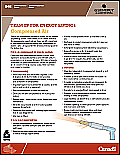
Heating and Cooling
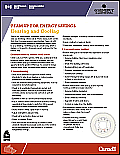
Fans and Pumps
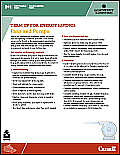
Steam and Condensate
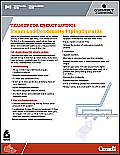
Slide Presentations
These slide presentations include speaking notes to help you quickly move ahead with your Employee Awareness Program. The presentations can be used in your campaign to encourage your employees to take action to reduce energy consumption.
To view the slides online, click on the presentation link below and select “Open”.
To view the slides and the speaking notes, right click on the mouse and choose the “Save target as” function. This enables you to save the presentation to your computer, view the speaking notes and modify the presentation to suit your organization's needs.
- Compressed Air (PowerPoint presentation)
- Fans and Pumps (PowerPoint presentation)
- Heating and Cooling (PowerPoint presentation)
- Lighting (PowerPoint presentation)
- Steam and Condensate (PowerPoint presentation)
- Waste Heat Recovery (PowerPoint presentation)
Stickers
Stickers are an excellent way to remind employees to use energy-efficient practices at the source. Place these easy-to-use, low-adhesive stickers, throughout your organization where they will have the most impact – in such places as on/off switches, meters, and entry and exit points.
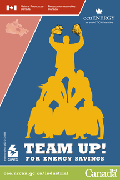
Page details
- Date modified:
